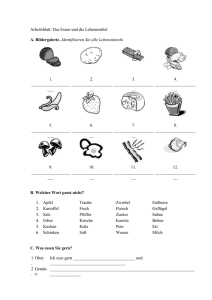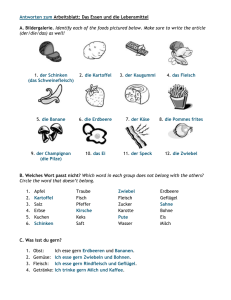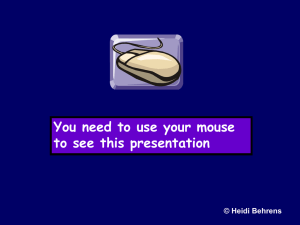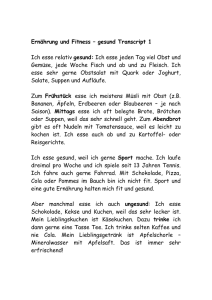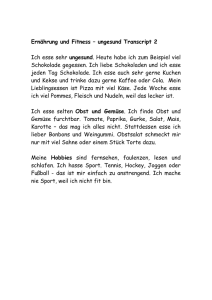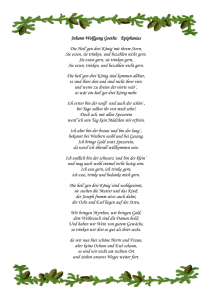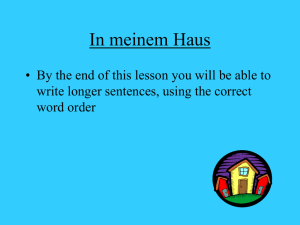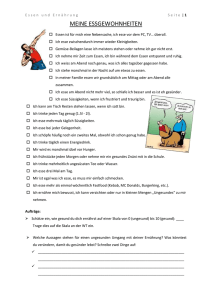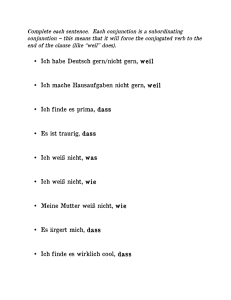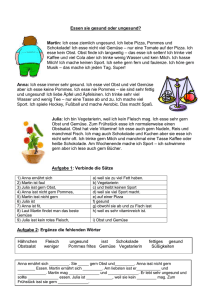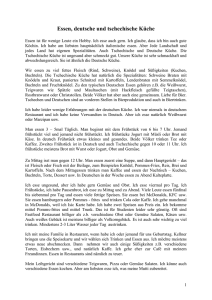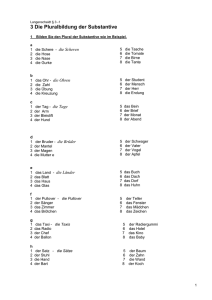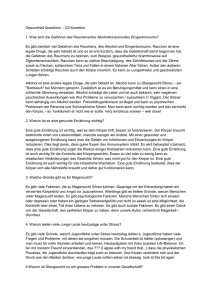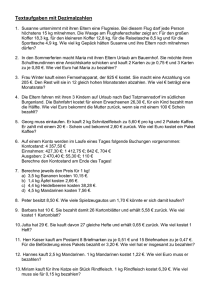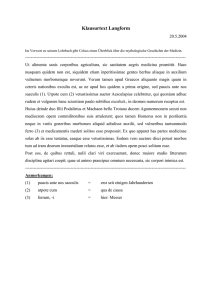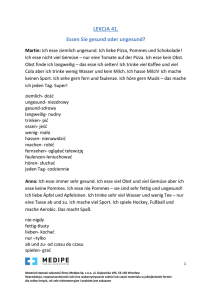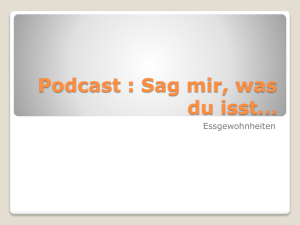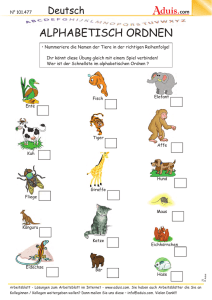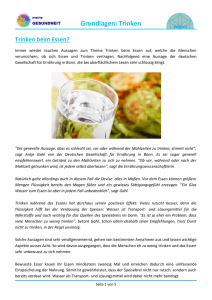Arbeitsblatt: Das Essen und die Lebensmittel
Werbung
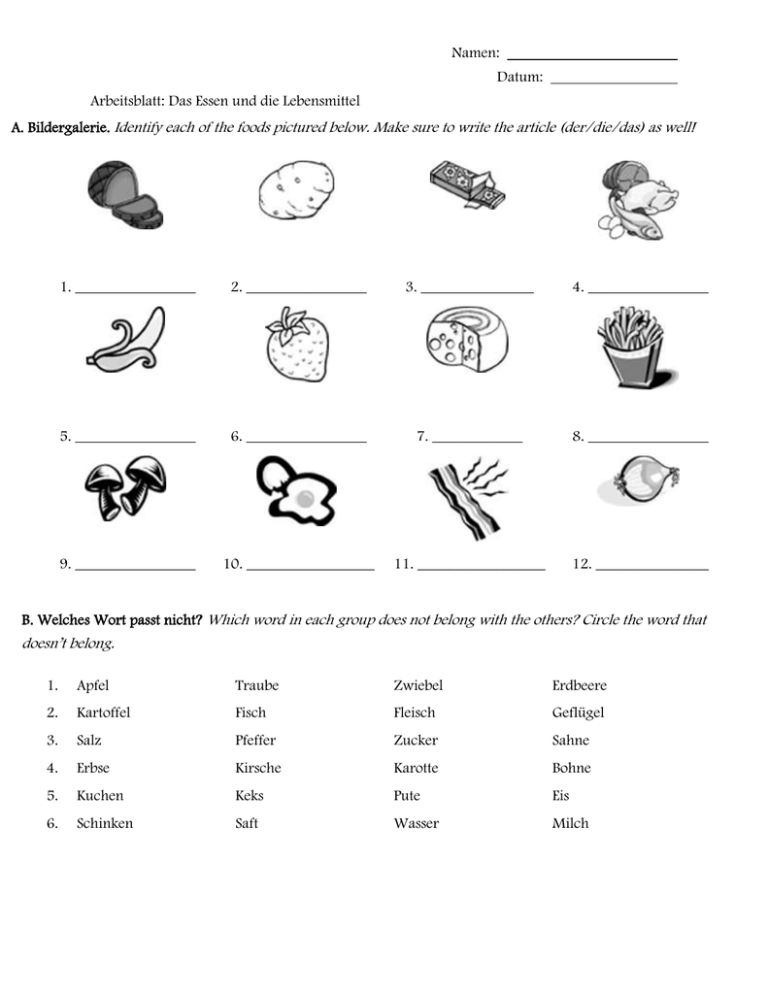
Namen: Datum: Arbeitsblatt: Das Essen und die Lebensmittel A. Bildergalerie. Identify each of the foods pictured below. Make sure to write the article (der/die/das) as well! 1. ________________ 2. ________________ 3. _______________ 4. ________________ 5. ________________ 6. ________________ 7. ____________ 8. ________________ 9. ________________ 10. _________________ 11. _________________ 12. _______________ B. Welches Wort passt nicht? Which word in each group does not belong with the others? Circle the word that doesn’t belong. 1. Apfel Traube Zwiebel Erdbeere 2. Kartoffel Fisch Fleisch Geflügel 3. Salz Pfeffer Zucker Sahne 4. Erbse Kirsche Karotte Bohne 5. Kuchen Keks Pute Eis 6. Schinken Saft Wasser Milch Namen: Datum: Arbeitsblatt: Das Essen und die Lebensmittel C. Was isst du gern? For each category of food, write a sentence saying what items you most like to eat or drink. Include at least two items for each category. You do not need to use articles in these sentences. 1. Obst: Ich esse gern _____________________________ und ___________________________________. 2. Gemüse: __________________________________________________________________________________. 3. Fleisch: __________________________________________________________________________________. 4. Getränke: __________________________________________________________________________________. D. Die Mahlzeiten. Now tell what you eat at each mealtime, again stating at least two items for each meal. 1. Zum Frühstück esse ich _________________________________________. Ich trinke ______________________. 2. Zum Mittagessen esse ich _______________________________________. Ich trinke ______________________. 3. Zum Abendessen esse ich _______________________________________. Ich trinke ______________________. 4. Als Nachspeise esse ich _________________________________________. Ich trinke ______________________. E. Assoziationen. What vocabulary words do you associate with the following? Many answers are possible; just choose two or three words that first come to mind. 1. Ein Obstsalat: Apfel, ... 2. Ein Omelette: 3. Ein Diät: 4. Ein Picknick: 5. Ostern (=Easter): 6. Weihnachten (=Christmas): 7. McDonald’s: 8. Pizza: Namen: Datum: Arbeitsblatt: Das Essen und die Lebensmittel F. Pluralformen. You will need to know the plural forms of some of the more common foods on your vocabulary list. Practice the plural forms here: fill in the blanks with the appropriate plural nouns. Auf dem Markt kauft Maria viele ________________________ (apples), _______________________ (oranges) und _____________________ (bananas). Sie kauft auch Gemüse, wie zum Beispiel _____________________ (peas), _____________________ (mushrooms) und __________________________ (potatoes). Dann geht sie in die Bäckerei und kauft sechs __________________________ (rolls) zum Frühstück. In der Konditorei kauft sie zwei _______________________ (cakes) und ein Dutzend _________________________ (cookies). Endlich geht sie zum Fleischer und kauft sechs ____________________ (sausages) und ein Dutzend _______________________ (eggs). Jetzt hat sie genug zum Essen! G. Was gibt es hier? Remember that the expression “es gibt” means ‘there is/are’, but that it takes an accusative noun. With that in mind, describe the picture below in a few sentences. Use the clues provided (articles are needed when indicated by ‘a’), and then add one or two sentences of your own. Es gibt _________ __________________ (a table) in dem Zimmer. Es gibt _________ ________________ (a cake) auf dem Tisch. Es gibt auch _____________ (wine) und _____________________ (beverages) auf dem Tisch. Es gibt auch _________ ______________ (a lamp) auf einem kleinen Tisch. Viele Leute ______________ (are eating) und _________________ (drinking). Ein Mann _____________ ______________ (is playing guitar), eine Frau bringt ________________ (coffee) ins Zimmer. Namen: Datum: Arbeitsblatt: Das Essen und die Lebensmittel BACK TO VOCABULARY WORKSHEETS -- WORKSHEET Antworten zum Arbeitsblatt: Das Essen und die Lebensmittel A. Bildergalerie. Identify each of the foods pictured below. Make sure to write the article (der/die/das) as well! 1. der Schinken (das Schweinefleisch) 2. die Kartoffel 3. der Kaugummi 4. das Fleisch 5. die Banane 6. die Erdbeere 7. der Käse 8. die Pommes frites 9. der Champignon (die Pilze) 10. das Ei 11. der Speck 12. die Zwiebel B. Welches Wort passt nicht? Which word in each group does not belong with the others? Circle the word that doesn’t belong. 1. 2. 3. 4. 5. 6. Apfel Kartoffel Salz Erbse Kuchen Schinken Traube Fisch Pfeffer Kirsche Keks Saft Zwiebel Fleisch Zucker Karotte Pute Wasser Erdbeere Geflügel Sahne Bohne Eis Milch Namen: Datum: Arbeitsblatt: Das Essen und die Lebensmittel C. Was isst du gern? For each category of food, write a sentence saying what items you most like to eat or drink. Include at least two items for each category. You do not need to use articles in these sentences. 1. 2. 3. 4. Obst: Ich esse gern Erdbeeren und Bananen. Gemüse: Ich esse gern Zwiebeln und Bohnen. Fleisch: Ich esse gern Rindfleisch und Geflügel. Getränke: Ich trinke gern Milch und Kaffee. D. Die Mahlzeiten. Now tell what you eat at each mealtime, again stating at least two items for each meal. 1. 2. 3. 4. Zum Frühstück esse ich Cornflakes und eine Banane. Ich trinke Milch oder Kaffee. Zum Mittagessen esse ich Suppe oder ein Sandwich. Ich trinke Milch. Zum Abendessen esse ich Pizza oder Nudeln. Ich trinke Saft. Als Nachspeise esse ich Kekse oder Bonbons. Ich trinke Kaffee. E. Assoziationen. What vocabulary words do you associate with the following? Many answers are possible; just choose two or three words that first come to mind. 1. 2. 3. 4. 5. 6. 7. 8. Ein Obstsalat: Apfel, Banane, Kirsche, Orange ... Ein Omelette: Ei (Eier), Käse, Salz, Pfeffer ... Ein Diät: Mineralwasser, Gemüse, Salat, Obst ... Ein Picknick: Cola, Kekse, Sandwich, Wein ... Ostern (=Easter): Schinken/Schweinefleisch, Ei (Eier), Bonbons ... Weihnachten (=Christmas): Pute, Kekse, Sahne, Bonbons ... McDonald’s: Hamburger, Pommes frites, Cola ... Pizza: Käse, Tomaten, Zwiebeln, Schinken ... F. Pluralformen. You will need to know the plural forms of some of the more common foods on your vocabulary list. Practice the plural forms here: fill in the blanks with the appropriate plural nouns. Auf dem Markt kauft Maria viele Äpfel, Orangen und Bananen. Sie kauft auch Gemüse, wie zum Beispiel Erbsen, Champignons und Kartoffeln. Dann geht sie in die Bäckerei und kauft sechs Brötchen zum Frühstück. In der Konditorei kauft sie zwei Kuchen und ein Dutzend Kekse. Endlich geht sie zum Fleischer und kauft sechs Würste und ein Dutzend Eier. Jetzt hat sie genug zum Essen! Namen: Datum: Arbeitsblatt: Das Essen und die Lebensmittel G. Was gibt es hier? Remember that the expression “es gibt” means ‘there is/are’, but that it takes an accusative noun. With that in mind, describe the picture below in a few sentences. Use the clues provided (articles are needed when indicated by ‘a’), and then add one or two sentences of your own. Es gibt einen Tisch in dem Zimmer. Es gibt einen Kuchen auf dem Tisch. Es gibt auch Wein und Getränke auf dem Tisch. Es gibt auch eine Lampe auf einem kleinen Tisch. Viele Leute essen und trinken. Ein Mann spielt Gitarre, eine Frau bringt Kaffee ins Zimmer. Zwei Männer singen, und ein Mann und eine Frau tanzen. Viele Leute hören die Musik. BACK TO VOCABULARY WORKSHEETS -- WORKSHEET
